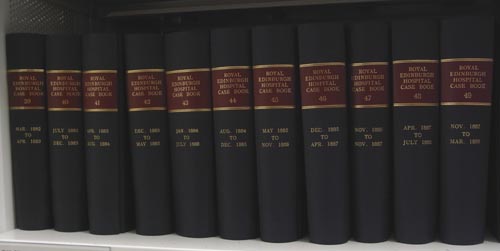Spotlight On...
Royal Edinburgh Hospital Case Books
The patient case books of the Royal Edinburgh Hospital (formerly Royal Edinburgh Asylum) are some of our most-used records. They are a series of 121 bound volumes covering the years 1840-1932 (our ref: LHB7/51). They contain detailed individual records of patients admitted to the hospital, including name, dates of admission, profession, marital status, home residence, religion, description of illness, duration of attack, treatment carried out, updates of their condition and dates of discharge or death. Occasionally, other documents are inserted into the casebooks giving further information. These enclosures include medical charts, letters by the patient, doctors and relatives, official memoranda and photographs.
The case books can be very useful for family historians tracking down an individual, or for academic research into a particular mental illness or patient demographic. All access to patient records is managed in accordance with the Data Protection Act 1998, the Freedom of Information (Scotland) Act 2002 and the NHS Records Management Code of Practice 2008.
To provide an example, below are the details of the case of George Forrester (LHB7/51/49) who was admitted to the Royal Edinburgh Asylum at 4.50pm on 27th July 1888.
George Forrester was a 42 year-old tailor, married and living at 5 West End Place, Edinburgh. The case book records that he was a pauper patient, which means that he was too poor
to pay for his own boarding at the Asylum, so this would have been paid for by the local authorities.
On arrival at the Asylum he was described as ‘generally moody & reserved’. The case books also provide us with some of his history. After hitting the top of his head on a mantelpiece he had became absent minded and incoherently talkative. It is reported that he randomly travelled to Ratho instead of going home and only returned at 6 the next morning. He was regarded as dangerous because he had thrown a tumbler at his sister. He was diagnosed as having 'General Paralysis', then a common form of mental illness caused by syphilis.
Patients of the Asylum were encouraged to work as part of their treatment. Forrester’s experience as a tailor meant that he could carry on this type of work, but as he is recorded to have proposed to make ‘coats for the whole world’ and began spoiling large amounts of cloth, he was given other duties.
Sadly, Forrester’s condition did not improve and he was transferred to the Asylum hospital during 1891 and died there on 6 May. The case book records that ‘He died today after being in a congestive attack five days, the convulsions were upon the left side’.
 |
Designed by the Learning Technology Section, © The University of Edinburgh

